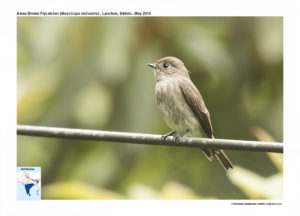Asian-brown Flycatcher

Asian Brown Flycatcher Muscicapa dauurica
Etymology :
- Muscicapa : Latin Word musca – fly; capere – to catch
- Dauurica : Dauria– south-eastern Siberia;, uri – a nomadic Mongolian tribe that inhabited the area
Vernacular Names : Hindi: Jhakki, Pun: Bhuri tik tiki, Guj: Bharati rato makhimar, Badami makhimar, Mal: Tavittupakshi, Mar: Tapkiri Mashimar
Distribution in India: Breeds in Himalayan foothill and hills of Central and West India. Widespread winter visitor in Central, South and East India.
Description:Size of 12-13 cm. The nominate race has head and upperparts plain ashy brown or grey-brown, broad whitish line on lores, whitish eye ring, indistinct short dark moustachial stripe; dark centers of crown feathers creating faint spotted appearance; flight-feathers sooty brown, narrowly edged ash-brown; fringes of upperwing-coverts and edges of tertials and inner secondaries dull greyish-white in fresh plumage ; tail sooty brown, narrowly tipped whitish; chin and center of throat white, throat side and breast suffused grey-brown, belly to undertail-coverts white; iris dark brown; upper mandible dark horn-coloured, lower mandible yellowish or yellowish-horn with extreme tip horn-coloured; legs blackish. Both the sexes are alike.
Habitat:It is found in breeding season in lowland open temperate and subtropical mature and secondary broadleaf forests, secondary woodland, forest and plantations, to 1800 m, also in mixed pine and broadleaf forest. In non-breeding season occurs in similar habitat, also in swamp-forest, parks, large wooded gardens, orchards, mangroves and scrub; on passage frequently in hilltop forest, coastal woodland, scrub and shelterbelts.
Food Habits: It eats small invertebrates, including beetles, stoneflies, bugs, wasps and larvae. It is unobtrusive and partly crepuscular, often inactive in shaded areas for main part of day. Has upright stance and often flicks wings and depresses tail. Forages from lower to middle levels of forest trees, in clearings and along edges, also from high open perches; frequently pursues insects in flight from perch, and often returns to same perch. Also snatches prey from among foliage and from tree bark; also drops to ground to take prey from grass or soil.
Breeding Habits: They breed in April-June in Himalayan foothill and hills of Central and West India. Nest is a small, compact cup of moss, lichens, grass, feathers, plant fibers and gossamer, on bare horizontal branch. It lays a clutch of 2–4 eggs. The incubation is done by female, usually fed by male.